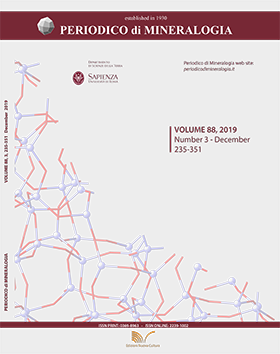Occurrence of new phosphides and sulfides of Ni, Co, V, and Mo from chromitite of the Othrys ophiolite complex (Central Greece)
DOI:
https://doi.org/10.2451/2019PM851Keywords:
Ni-V-Co-phosphides, V-sulfide, chromitite, Agios Stefanos mine, ophiolite, Othrys, Greece.Abstract
Several unnamed phosphides of Ni, Co, V, Mo, and one V-sulfide grain are recovered from heavy-mineral concentrates, obtained from a composite chromitite sample of the Agios Stefanos occurrence (Othrys ophiolite, Central Greece). The minerals were identified essentially with electron microprobe analysis. Most of the phosphides have a stoichiometry similar to allabogdanite or barringerite, the orthorhombic and hexagonal forms of (Fe,Ni)2P respectively, but show significant proportions of Co, V, and Mo. Based on the dominant metal in the calculated formula, the minerals could correspond to a Ni-allabogdanite or Ni-barringerite, and to a V-allabogdanite or V-barringerite. More complex stoichiometries are observed when Mo is the dominant metal, and thus it leads to a potentially new (Mo,V,Fe)3(Ni,Co)2P phosphide mineral. The unnamed sulfide corresponds to the ideal formula VS, with trace amounts of Ni, Fe, Co and Mo. All the grains vary in size between 5 and 80 μm, and are characterized by distinctive reflectance and other optical properties such as color and isotropy-anisotropy. In contrast, Raman spectra are not significantly distinctive.
The suite of rare minerals occurs intimately intergrown with brecciated chromite, accessory awaruite, and various sulfides produced by alteration of chromitite under reducing conditions. This indicates that the minerals are products of natural processes, and do not represent contaminants related to the sample preparation. Interpretation of their origin is still rather speculative embracing a number of possible processes: i) high-temperature reaction of the chromitites with reducing fluids, at mantle depth, ii) low-temperature alteration of chromitite during sub-oceanic serpentinization, iii) post-orogenic, surface lightning strike, or iv) meteorite impact (astrobleme). The rare and localized occurrence of the Othrys phosphide minerals may bear some support to the two last models.
The minerals described in this work potentially represent new mineral species that are still under study for a complete crystallographic characterization, as required for the acceptance by the IMA Commission on New Minerals, Nomenclature and Classification.


